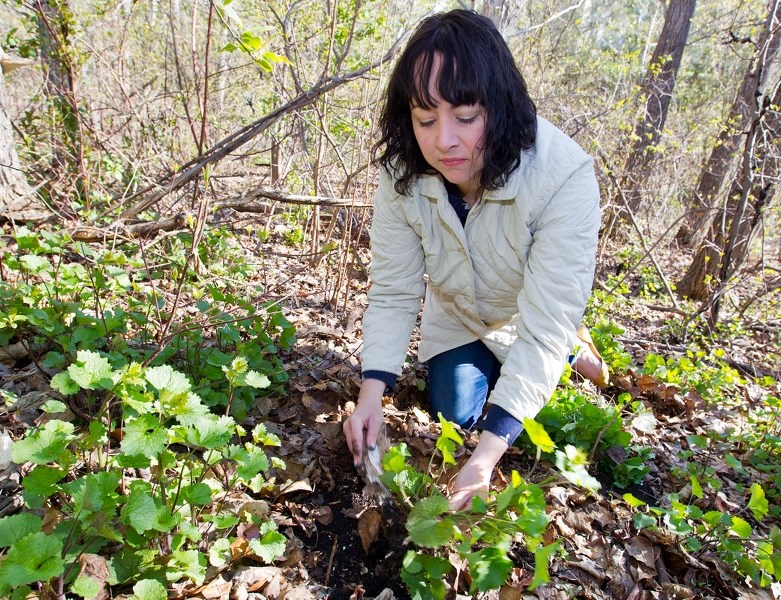A St. Albert biologist is helping Alberta get a grip on its garlic mustard infestation.
MacEwan University biology professor Melissa Hills and her research team did a survey of garlic mustard populations in the Forest Lawn Ravine last month. The survey is part of the team's ongoing research into the invasive weed's spread in Alberta.
Garlic mustard is an invasive weed that's running rampant throughout North America, says Hills, who lives in St. Albert. It first showed up in Alberta in 2010, and is now entrenched in four ravines: three in Edmonton and the Forest Lawn ravine in St. Albert.
"It's being called the mother of all invasive plants," she says.
St. Albert public works officials moved into the Forest Lawn ravine this week to pull as much of the weed as they could find, says city arbourist Kevin Veenstra.
With Hills' help, Veenstra and his crew spot several patches of ankle-high, leafy garlic mustard plants just off the ravine trail Monday and started grabbing and bagging them.
Worst of the worst
Garlic mustard is a herbaceous plant known for its heart-shaped, scallop-edged leaves that smell like garlic when crushed, Hills says. It has small white flowers, grows up to a meter tall, and tastes good in salads and pesto. It should not be confused with native violets, which has similar leaves but lacks the garlic smell.
Veenstra says garlic mustard is particularly noticeable right now, as it's one of the first plants to emerge in the spring.
Garlic mustard is classified as a prohibited noxious weed in Alberta, which means governments are legally obliged to destroy it on sight. It's notorious for its ability to swiftly crowd out all other native plants in an area, threatening biodiversity.
Garlic mustard does this in part by getting an early start on growth, Hills says – they can germinate when it's close to 0 C. Once it germinates, it secretes allopathic chemicals to poison the soil against anything but garlic mustard.
Each plant can make about a thousand seeds, each of which can survive up to 10 years, Hills says. Research also suggests that the plants produce more seeds when they sense they have fewer neighbours, meaning that any one plant missed during a sweep could restart the invasion.
These seeds spread easily on shoes, pets and bikes, Hills says.
Hills has had her students studying the weed for the last couple of years as a way to get some practical experience. These studies include population surveys, winter survival rates and DNA analysis.
Initial surveys suggest that St. Albert's population is contained within Forest Lawn ravine, Hills says – a fact she attributes to the city's aggressive control campaign. Edmonton's infestation is running rampant and now covers about seven blocks of forest.
Veenstra says the plant probably arrived in St. Albert through someone's garden, as he's noticed that most of the plants in the Forest Lawn ravine seem to be spilling down from backyards. Compost heaps are another vector: he points out how one big patch of the plant seems to spill down from a compost heap in one person's yard.
The city has pulled and sprayed these weeds many times in the last five years, but they keep coming back. Research suggests that people have to eliminate at least 85 per cent of the garlic mustard in an area before they make a dent its population, Hills says.
"St. Albert is doing a good job because they are investing the resources that are necessary," Hills says.
She called on the province to give municipalities more support in order to get this invasive weed under control.
Anyone who spots an invasive weed like garlic mustard should report its location to public works, Hills says.
If you decided to pull garlic mustard, make sure you get all of its extensive taproot and that you dispose of the plant in the trash, not the compost, Veenstra says.
Hills says people and pets should stick to the trails in infested areas like Forest Lawn ravine to avoid spreading the plant's seeds.
Veenstra says the city will hold a garlic mustard pull in the ravine this June 5.
Invasive plant questions should go to public works at 780-459-1557.




